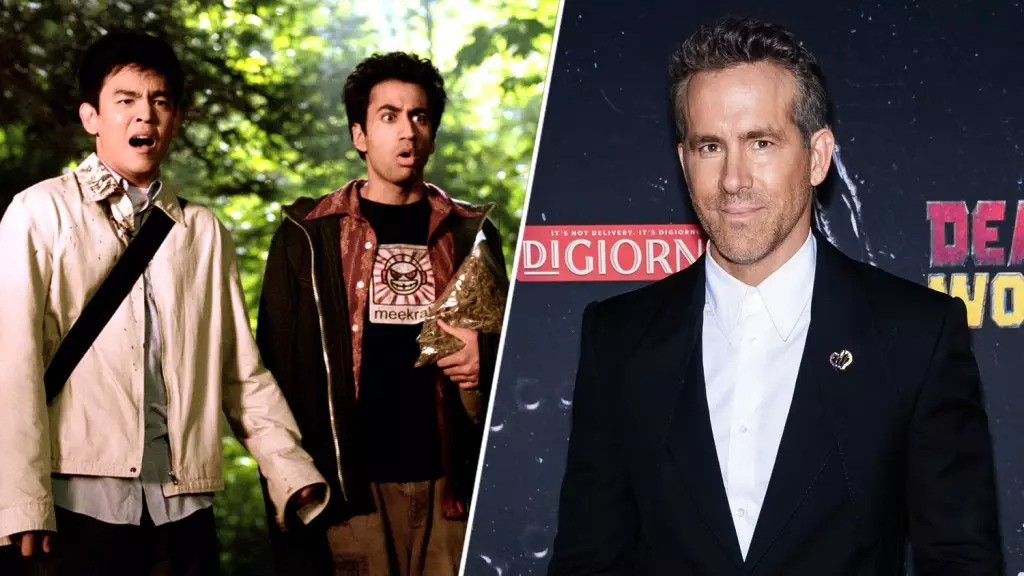As the iconic film *Harold & Kumar Go to White Castle* celebrates its 20th anniversary, it’s a perfect time to reflect on the behind-the-scenes stories that shaped this beloved stoner comedy. While John Cho and Kal Penn are often acknowledged for their memorable performances, it’s crucial to recognize the pivotal role that Ryan Reynolds played in bringing this film to fruition. His involvement not only helped launch the career of his co-star but also contributed to the film’s overall success, making it a cornerstone of early 2000s comedy.
The connection between Reynolds and *Harold & Kumar* can be traced back to their collaboration in *National Lampoon’s Van Wilder* (2002). During the audition process, Kal Penn faced the challenge of competing against a more conventional option for the role of an Indian exchange student—something that raised eyebrows in retrospect. However, Reynolds emerged as a beacon of support during this tense moment. His encouragement was not merely passive; he engaged actively in the audition, advocating for Penn’s talent and improvisational skills. This instance of camaraderie would lay the foundation for what would become an influential partnership.
In their conversation, Reynolds initiated a dialogue about future projects, expressing his willingness to step in should Penn secure a leading role. This promise was more than just a friendly gesture; it indicated Reynolds’ vision of supporting diverse narratives in filmmaking, a rarity in Hollywood at the time.
When *Harold & Kumar Go to White Castle* was in its developmental phase, producer Nathan Kahane faced the challenge of securing known names to lend credibility to the project. The studio was particularly focused on adding three cameos, which they believed would enhance their marketing prospects. It was a lucid idea to create a fuller cinematic experience, particularly with an ensemble of relatively unknown actors.
Kahane’s recollection of reaching out to Ryan Reynolds exemplifies the type of support that can often make or break independent films. Reynolds, initially just a supportive colleague, became a linchpin in the film’s journey to production. He agreed to appear for a fee of $10,000, demonstrating his commitment to Penn and the project. It was a strategic move that ultimately catalyzed the greenlighting of the movie, showcasing the impact that one individual’s enthusiasm and willingness to collaborate can have in an industry driven by finances and star power.
The film, which follows two roommates on a quest for fast food, gained a cult following, made significant strides in representing the Asian American community in film, and cemented Reynolds’ status as a versatile comedic actor. Reynolds’ cameo as a frantic nurse was not just a fleeting moment; it encapsulated the spirit of chaos and camaraderie that defines the *Harold & Kumar* franchise.
The legacy of this collaboration has continued to thrive over the years. With sequels like *Harold & Kumar Escape from Guantanamo Bay* (2008) and *A Very Harold & Kumar Christmas* (2011), Penn and Cho have built a lasting rapport, which remains significant amongst fans. As discussions for a potential fourth installment of the franchise circulate, it’s clear that the bond created during the first film remains unbreakable.
As we celebrate 20 years of *Harold & Kumar Go to White Castle*, it’s vital to acknowledge the collaborative efforts that brought it to life. Ryan Reynolds, often recognized today for his leading roles in superhero films, played an instrumental part in shaping this cult classic. By lending his support, he not only facilitated Penn’s breakthrough but also enriched the comedic landscape with a film that defied conventional stereotypes. This celebration is not just about a film turning 20; it’s about the collaborative spirit in Hollywood that fosters diverse stories and voices—a spirit that Ryan Reynolds embodies beautifully.


Leave a Reply